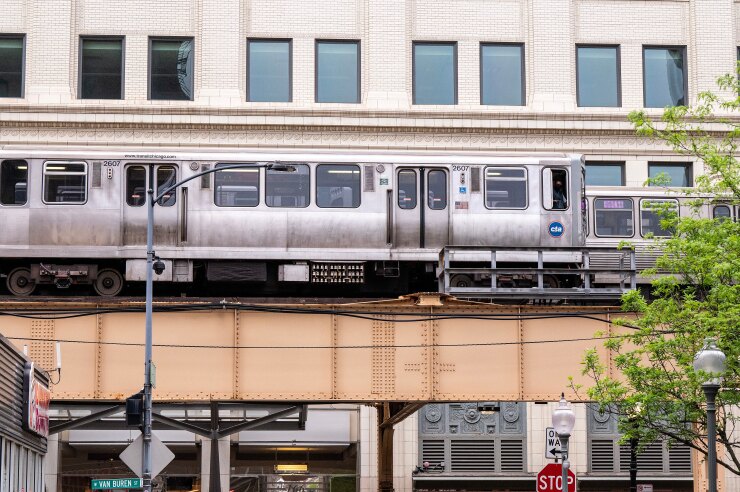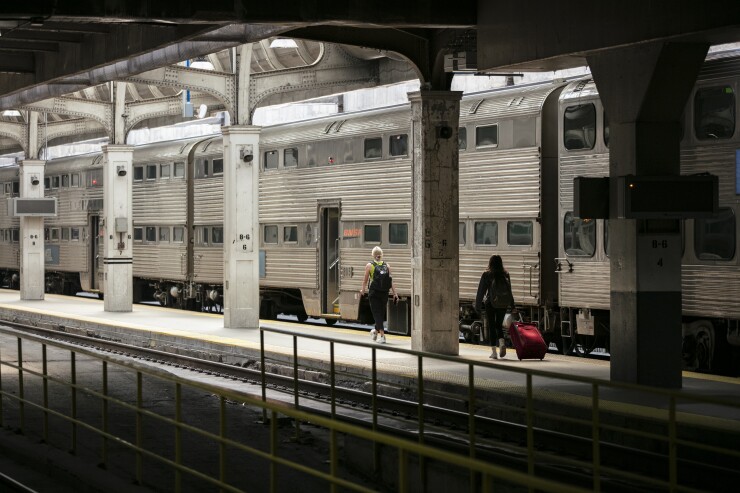Illinois lawmakers move to consolidate Chicago regional transit
6 min read

Lawmakers in the Illinois General Assembly have proposed legislation to abolish the multiple service boards operating public transit in the Chicago area and consolidate them under a new Metropolitan Mobility Authority.
At present, the Regional Transportation Authority oversees finances, funding and planning for the Chicago Transit Authority, which provides local rail and bus service in the city; Metra, which runs commuter trains from the suburbs to Chicago; and Pace, which provides suburban bus service.
Both the CTA and the RTA are significant issuers of municipal bonds.
Bloomberg News
The move to consolidate follows a December
CMAP is a transportation and land use planning agency that covers all seven counties in northeastern Illinois. Tasked by the General Assembly with devising legislative recommendations to address the looming budget crisis, CMAP recommended changes to revenue sources and governance practices that included $1.5 billion in new operating support for transit from the state and $400 million in annual capital investments.
The agency also called for expanding the state sales tax base to include additional services and replacing the motor fuel tax surcharge with funds from congestion pricing or tolling.
Among the governance changes suggested by CMAP was to either create a single regional entity or to empower a regional coordinating agency but maintain the service boards.
State Sen. Ram Villivalam, D-Chicago, and state representatives Eva-Dina Delgado, D-Chicago, and Kam Buckner, D-Chicago, have taken CMAP up on its suggestions, following the first of the two governance paths laid out in the report.
Delgado told The Bond Buyer that she opted for the first path because it “is more likely to result in an integrated regional transit governance structure” and a regionally responsive, efficient transit system.
Villivalam’s bill, SB3936, as well as Delgado’s and Buckner’s bills, HB5829 and HB5823, carve out a territory for the MMA of Cook, DuPage, Kane, Lake, McHenry and Will counties, the same area under the umbrella of the present-day RTA. Under the legislation, the MMA would be created as a unit of local government and municipal corporation.
The assets of the consolidated transit systems would be vested in the new authority without impairments.
“To the fullest extent allowed by applicable law, the Authority shall succeed to all the rights, assets, franchises, contracts, property, and interests of every kind of the consolidated entities,”
“It’s very early in the legislative process to have detailed consolidation plans,” Delgado said. “But the intent would be for the MMA to assume all outstanding debt of RTA and CTA and honor those debt obligations.”
Jennie Vana, CMAP’s deputy of communications and engagement, said CMAP staff is reviewing the legislation on the table to provide legislators with more detailed input aligned with CMAP’s report.
“Some of our key takeaways so far have been to ensure we are maintaining the three-legged stool approach that we took in the PART report as the focus now shifts to legislative action,” she said. “Decisions about how we improve the system, how we fund it and how we govern it are all interlinked.”
Vana noted that there is also a supplemental bill being considered that would provide up to $1.5 billion for transit.
“The $1.5 billion aligns with our PART recommendations,” she said. “Only filling the $730 million gap wouldn’t improve service, just maintain the status quo. The additional funding would support needed investments in additional service — better buses, increased accessibility, et cetera. It’s important that funding, governance, and system improvements are all considered at the same time.”
Delgado said the $1.5 billion is intended to go toward improvements in service frequency, time-of-day service coverage and enhanced reliability.

Bloomberg News
The proposed legislation also calls on the MMA to adopt a strategic plan every five years that includes information about operating expenses, debt service, pension and other post-employment benefits contributions and availability of working capital, among other things.
Bonds or notes issued by the MMA “shall be pledged the full faith and credit of the authority,”
The legislation further stipulates that neither state assistance nor additional financial assistance may be pledged as general revenues of the authority or as a security for bonds that it issues. The authority cannot assign its right to receive such assistance or direct payment of such assistance to a trustee for the payment of debt service on its bonds.
The finances of the new authority will be controlled by a board that can appropriate money for payment of debts. Under the proposed legislation, the board will be composed of both voting and nonvoting directors.
Voting directors would include three directors appointed by the governor; five directors appointed by Chicago’s mayor, one of whom must be the commissioner of the Mayor’s Office for People with Disabilities; five directors appointed by the president of the Cook County Board of Commissioners; and one director appointed by each of the chairs of the respective county boards.
The nonvoting directors would include the secretary of transportation or the secretary’s designee; the chair of the board of directors of the Illinois State Toll Highway Authority; a governor-appointed representative of organized labor; a representative of the metropolitan business community, appointed by the board’s voting members; a representative of the disability community, appointed by the board’s voting members; and the chair of the Citizens Advisory Board established by the legislation.
Chairman of the RTA Board of Directors Kirk Dillard said that the Chicago region’s public transit operations have been “chronically underfunded” compared with peer regions, a shortfall in support that predates the pandemic.
“We welcome discussion on reforms that strengthen coordination, efficiency and accountability across the regional transit system,” he said. “Riders expect and deserve faster, more reliable service, and a safer and more accessible system. But reforms must come with the necessary funding to upgrade service and maximize transit’s impact on the region’s economy, climate, and access to opportunity for all residents.”
In a
Noting that 2024’s projected ridership is still at just 62% of the level reached in 2019, the Civic Federation advocated a full restructuring of the region’s transit systems.
“The Civic Federation supports the integration of the three transit agencies with the Regional Transportation Authority into a single regional transit agency,” the report said, calling consolidation “a comprehensive solution capable of addressing many of the existing operational inefficiencies while also solving for the calcified cultures, politics and bureaucratic competition dragging down our troubled system.”
In its most
The CTA, in its most
The CTA’s senior lien sales tax revenue bonds are rated A1 by Moody’s Ratings, AA by S&P Global Ratings and AA by Kroll Bond Rating Agency, according to the
The RTA’s general obligation bonds and notes, secured by pledged authority sales taxes in its six counties, are rated AA-plus by Fitch Ratings, Aa3 by Moody’s and AA by S&P, according







